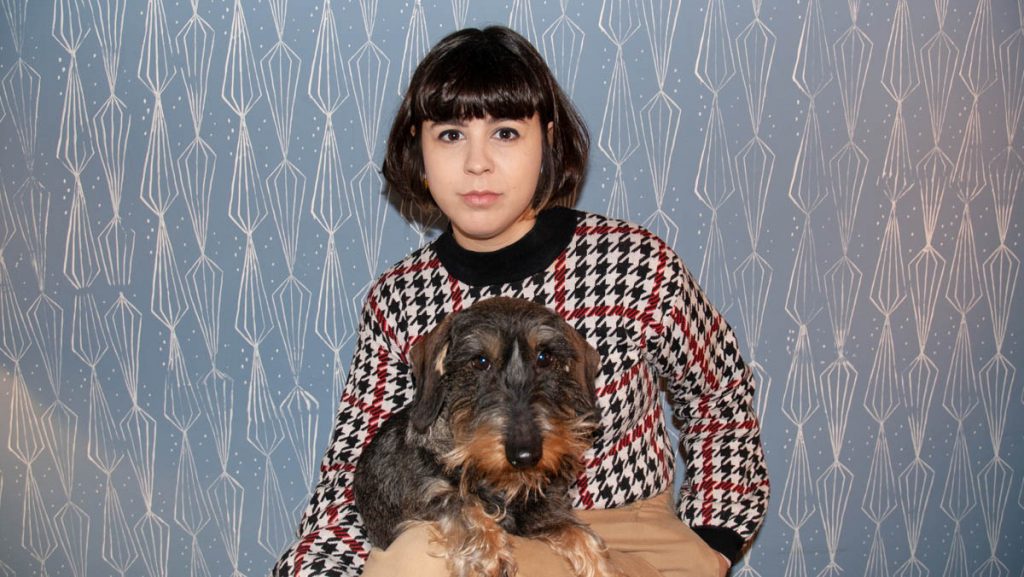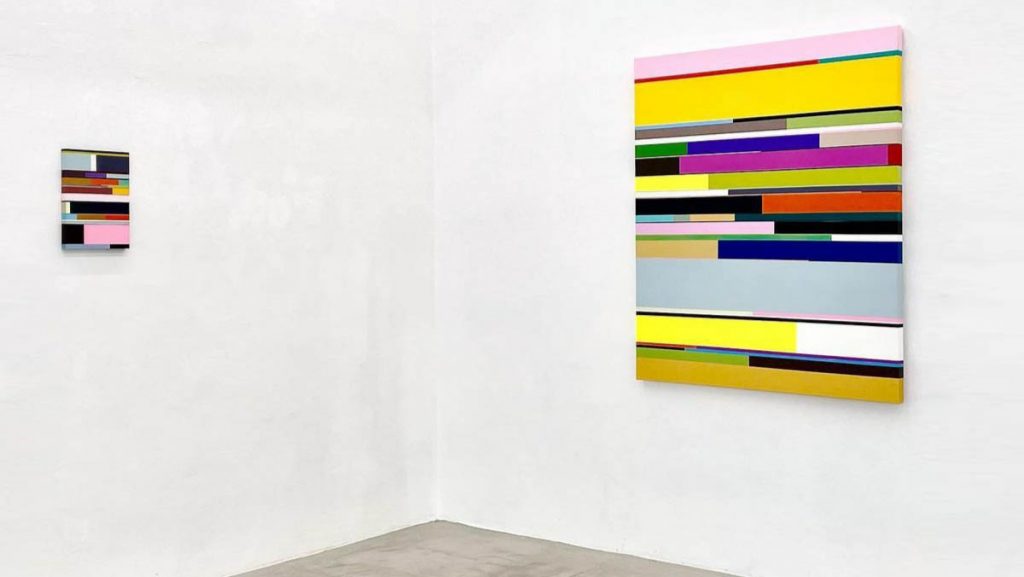It is inspiring that the gallery in Naples now represents so many international artists. When reading about one of the artists that your gallery represents, I read the moving case of Eugenio Tibaldi. He says in a statement: „Since 2000 I have lived in Varcaturo, a „peripheral suburban neighborhood“ to the north of Naples. I come from Alba (CN), a small provincial town; I moved there in order to discover and experience the most malleable and fluid place in Italy“. Is he the only artists that the gallery represents that moved to Naples? What these humans, artists give to the city?
U.D.M: As I wrote before, the gallery is born from the observation of the political and social dynamics of my territory. Obviously, the Neapolitan reality has always been a matter of discussion with the artists.
It was not just a superficial fascination, they were able to give a new point of view on the social, historical and anthropological characteristics of this region through their own research.
A perfect example is the second solo show by Sergio Vega in the gallery, Hashish in Naples. Following the Walter Benjamin scripts in “Immagini di città,” Sergio tried to redesign the map of Naples by combining his experiences with the portrait of the city that Benjamin made in the 1920s.
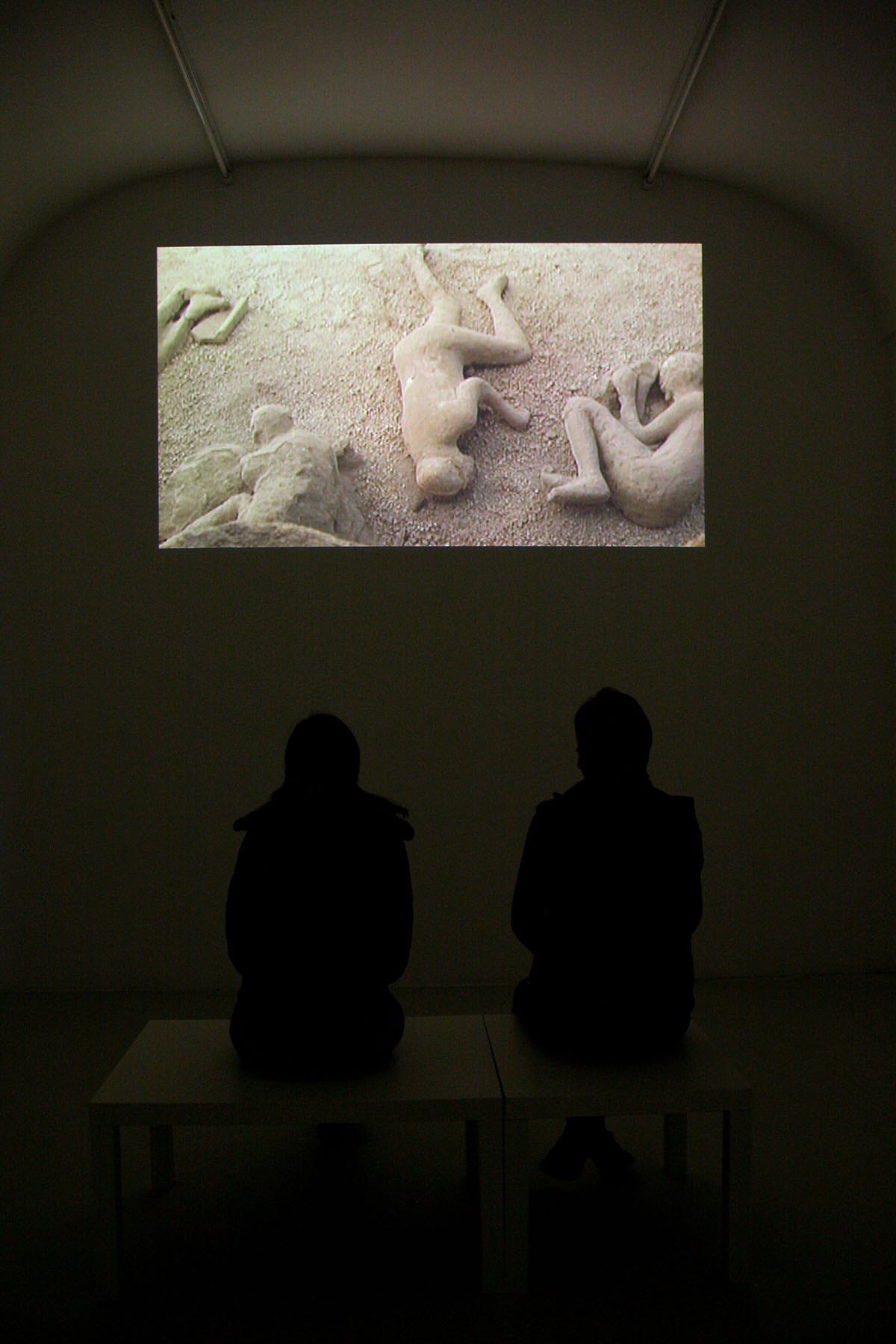
This is quite emblematic of the relationship that our artists have with the city of Naples, and in fact, Eugenio Tibaldi was not the only one who decided to move here. He moved to Naples when he was very young for a specific interest in these “marginal areas,” that allowed him to transform this interest in his artistic practice, and like him many of the artists of the gallery have decided to live temporarily in the city.
This is the case with Jota Castro, Satoshi Hirose and of course, Sergio Vega. I intentionally encourage the artists to spend quite a lot of time in the city, inviting them into a sort of full immersion residency in the reality of Naples and its suburbs.
Sometimes, I see that humanity needs defining, labeling. Many words have been used to describe these times: bizarre, new normality, disquieted, Novel Coronavirus. We even have a crisis glossary catalog with the new terms. Do you have such a need, if yes, what attributes you give to these times?
U.D.M: Honestly, I feel a bit annoyed by the various definitions given about this moment. I believe that it is still early to think of analyzing what is happening today and the hypothetical social, economic or health consequences of this period. We are still in the middle of an unprecedented event, we haven’t even the tools to understand or historicize it. It will certainly be a period of transition, we as a gallery are ready to restart with a „normal“ program, as I imagine many other colleagues are. I think that we will only be able to see how much the world, the system, the market will have changed in the future. But I wonder if we are all aware of what the „stakes“ are.
Can we define ourselves as a collective mechanism composed of individuals able to think and define themselves as such? I believe this should be the main core of our present: identifying common challenges and aims, understanding our stakes; only this process will give us a proper art system. I don’t think we should feed the glorification of good intentions, but probably, as a system, we should overcome the challenges coming from the outside using our knowledge, instead of simply talking about it.
You are part of many Italian art fairs, but also international ones. How important are art fairs for a gallery? Based on which criteria you decide the participation in art fairs?
U.D.M: Yes, art fairs are a huge part of our activity. We choose the fairs based on a possible interest they could have in our research as a gallery and in the work of our artists. In Italy, we take part in the main national fairs such as Artissima in Turin, Miart in Milan and ArtFiera in Bologna. I strongly believe that the national market is fundamental, but I do not feel that the gallery is dependent on this. In fact, as you said yourself, the gallery has participated in several international fairs.
Obviously, abroad we tend to consider the fairs that have a specific interest in our program, and it’s not a coincidence that in the last years the gallery has been invited to different curated sections of art fairs.
It is the case of the invitation received with Pedro Neves Marques to Futuro, at ARCO Madrid section in 2018, curated by Chus Martinez, Elise Lammer and Rosa Lléo, or as in the case of Sergio Vega at Untitled 2018 in Miami curated by Omar López-Chahoud where we realized a site-specific project in the fair’s spaces. In April 2020 we had planned to participate at arteBA in Buenos Aires with Sergio Vega, where we were invited by two directors of Kunsthalle Lissabon in Lisbon, Joao Murao and Luis Silva.
Unfortunately, the fair was canceled and transferred “online,” but I really hope to have the opportunity to participate in a real version of ArteBa. As a Neapolitan, I feel extremely connected to that area of South America, and the fair seems to offer an interesting program and well-curated sections.
Art Fairs, how important are they for the gallery operations, and what do they mean at you?
U.D.M: The market is an important recognition for our job, but beyond the sales, I’m always incredibly fascinated by the structure of the art system staged during week-long fairs. We meet once again with our collectors, colleagues and friends, with the addition of having the opportunity to visit many exhibitions and museums in the city.
There is always a nice and friendly atmosphere and despite the frenetic and highly stressful rhythms, I am incredibly attracted by that feeling to be at the exact center of a system, of being a fundamental mechanism of it.
When a fair is taking place, contemporary art is always the main cultural activity in the city, as opposed to its usual role as, especially in Italy, a marginal one.
In 2020 we also had many online art fairs, and you have participated in a couple of them. What is your feeling/experience? Can all art media fit with the format of digital art fairs?
Yes, Intersect Chicago (The future of the sofa), as well as Intersect Aspen, are two online fairs we took part in this year. We were invited by Paul Laster and during the first lockdown it seemed to be the only way to keep the gallery activity alive. It was a nice and new experience, the fair was incredibly organized with an array of different digital content, but I felt conflicting emotions regarding the world of online fairs, to be honest. I’m pretty sure that we will see massive digitization of many aspects related to our jobs, such as studio visits, seminars, conferences and various events, but regarding the state of fairs, currently, I have the feeling that for a gallery based on research it is still problematic to take part in these kinds of events. The complexity of our artists and our gallery doesn’t fit well with the digital strategies we’ve seen in this period, which probably could be perfect for an easier language or for commercial phenomena.
Considering how online fairs are currently configured, I don’t think that we can translate all art into “digital.”
How many things you had to cancel or postpone because of the pandemic?
U.D.M: Definitely too many. In 2020 we had planned six exhibitions in the gallery, but due to closing periods and various postponements, we managed to do only two of them (the solo show of Ana Manso and the one of Pedro Neves Marques).
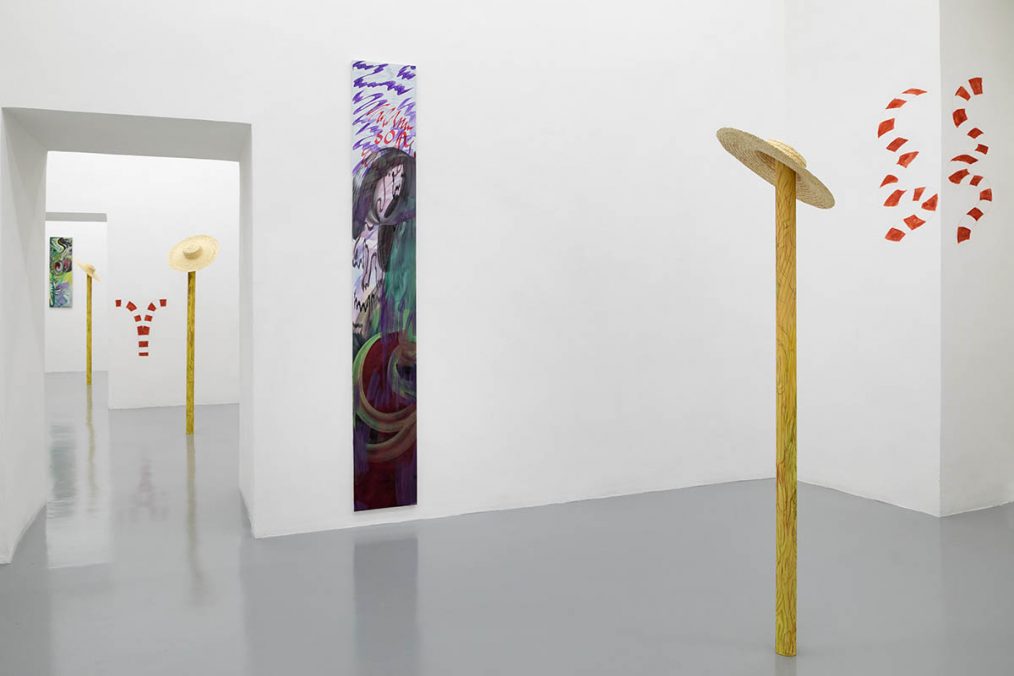
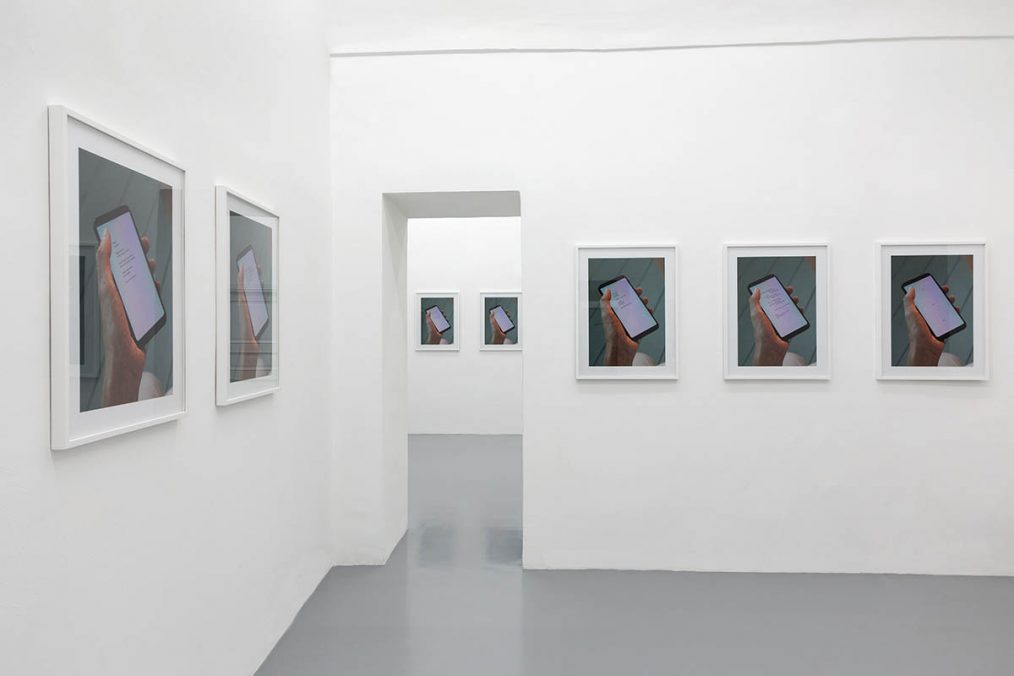
Pedro Neves Marques, Autofiction, 2020, exhibition view at Gallery Umberto Di Marino. Photo: Courtesy of Danilo Donzelli
We had also started to work on a new location for the gallery, which unfortunately due to the pandemic was postponed to 2021. Obviously, we had to give up all those opportunities that allow us to travel and discover new things such as fairs or various biennials; for example, in 2020 we were planning to visit the Liverpool Biennale as two of our artists (André Romao and Pedro Neves Marques) were invited to participate. This year we are very determined to pick up where we left off, trying to carry out all the projects we had in mind for 2020, in order to start working more concretely on the future of the gallery.
Has the pandemic changed anything/something in the way how you direct the gallery?How do you want to build the future?
U.D.M: Actually, before the pandemic, I felt the need to change something in the structure of the gallery. In the last two years, I have often reflected on how the art system was changing, on how certain overproduction processes, typical of cognitive capitalism, were also being generated within our system. I tried to answer this question by erasing what I considered unnecessary from the event of an “exhibition.”
Placing again the artwork and the artist’s research at the center, I wanted to generate from a rigid perspective the possibility for a new debate. With “Visto da qui” I tried to question the structure of the „gallery“ institution, and it is precisely from here that I imagined a possible trajectory for the future of the gallery. I’ve been thinking about the concept of a home-gallery lately.
The idea is to transform the gallery level. We have recently purchased an almost 400 square meters space in a historic building in the center of Naples, where we will try to realize the idea of a gallery as a common good. I really want to invite the public to consider our spaces as a starting point and an opportunity for a more organic and personal involvement in the gallery’s activity.
How would you describe your collectors?
U.D.M: It is not easy to draw a unique portrait of our collectors. I can recognize for sure an incredible involvement in the gallery’s activity that is a common factor for all of them. As for the artists, I believe it is essential to maintain a deep connection with collectors, building a relationship based on mutual exchange. That’s why I can easily affirm that, as I gave something to them, I have also learned a lot. I remember with pleasure Ovidio Jacorossi and Anna Rosa and Giovanni Cotroneo, who had the courage to come to the Neapolitan province, going above all the territorial (or regional) prejudices. They were moved by a strong passion for art and by the quality of the work of the artists.
They taught me how to distinguish the true passion from a speculative interest.
Today I see that same emotional involvement in some younger collections such as the Agovino Collection and the Taurisano Collection. They have been able to go above the desire of collecting, creating a real network around the collection activity, supporting the work of young artists and curators. We can define them as proper institutions.
Since 2018, you are cooperating in a regular basis with Aquapetra Parco D’Arte. How did this cooperation between an art gallery and a holiday resort emerge?
We chose Aquapetra because, as you noticed, it is probably the best place to show this installation, but also because the owner is trying to build a different idea of a luxury resort, a place where you could have a not banal „luxury experience“.It’s not something easy to find in our territory and we are more than happy to help him in this idea.
That’s pretty important for us, going beyond the „borders“ of the gallery’s spaces, creating a dialogue with our city and our territory.
Do you have alike projects where the gallery goes beyond the gallery borders, its space, architecture?
U.D.M: For the 20th anniversary of the gallery we organized some events in the city, and from then, we actively continue this dialogue as we think it’s something not common in the „gallery’s soul“. You can check for example „ten more ten“ and the others „outdoor“ projects, at the events section of our website. The last project we managed to realize in different places was the Jota Castro exhibition CAVE CANEM. This exhibition is quite emblematic of our attitude as a gallery.
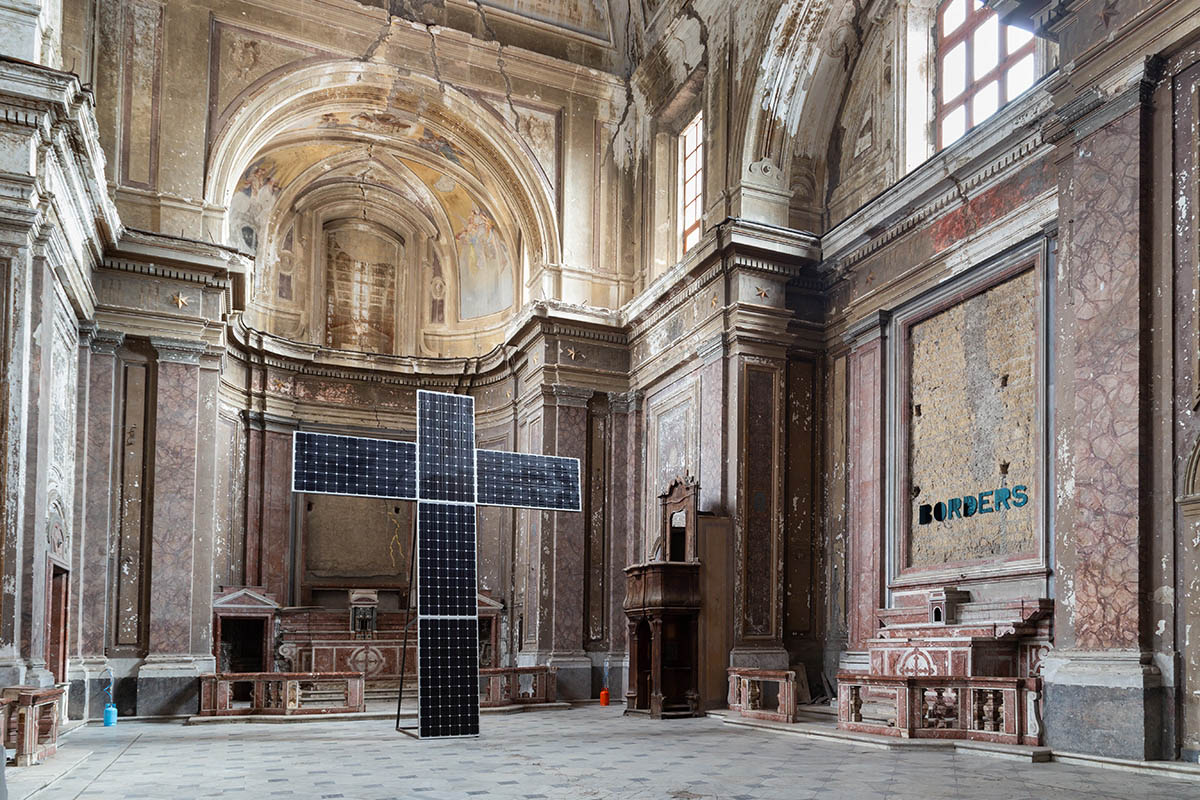
Photo: Courtesy of Danilo Donzelli
Adress and Contact:
Galleria Umberto Di Marino
Via Alabardieri, 1 – 80121 Napoli
Tel. +39 081 0609318
info@galleriaumbertodimarino.com
www.galleriaumbertodimarino.com
Erka Shalari (*1988, Tirana) is a Vienna-based art author. She focuses on discovering unique artistic positions, unconventional exhibition spaces, and galleries that have deliberately broken new ground in their working methods. She relies on unorthodox publishing practices, coupling these with a nonchalant manner of writing. Her work oscillates between articles for magazines, exhibition texts and press releases – https://linktr.ee/erkashalari



